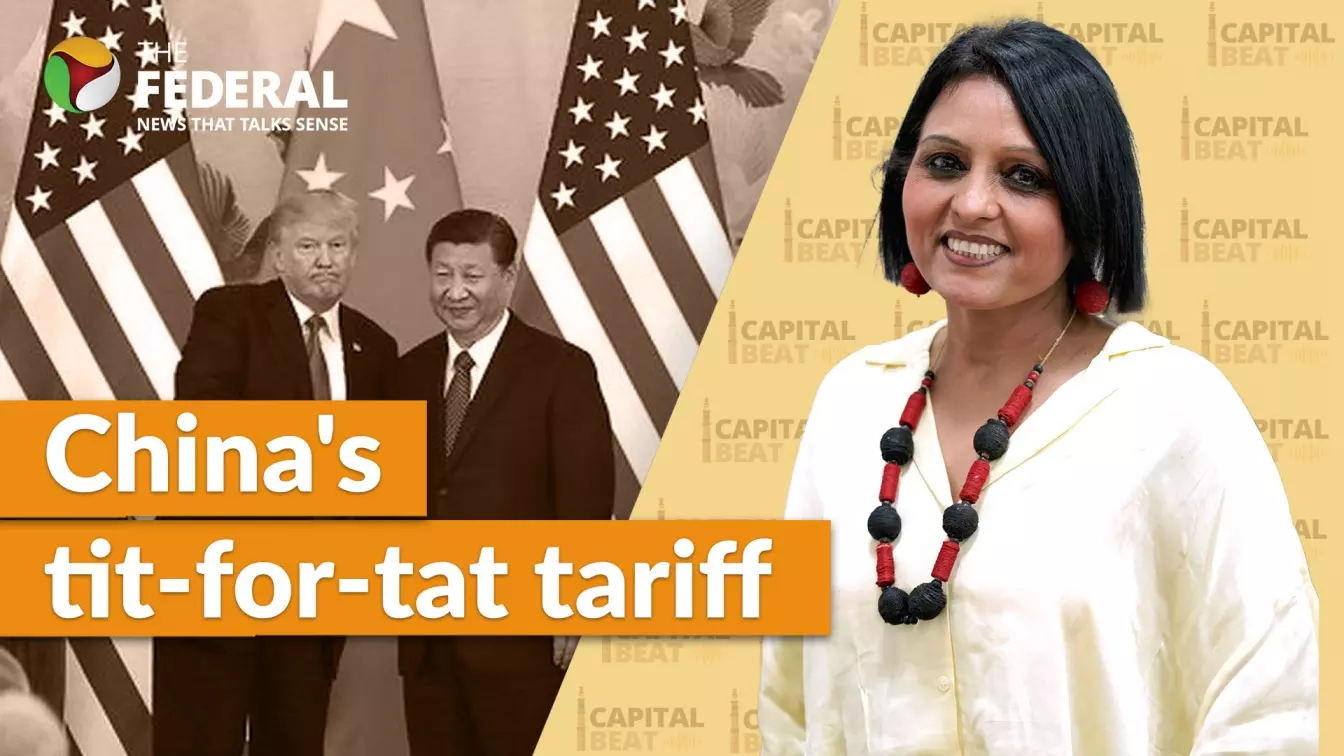
As China replies to US with tariff hike, where does India stand in global trade war?
As the US and China raise tariffs against each other, is a global trade war inevitable — and what will it mean for India and the world?

In a high-stakes episode of Capital Beat, political economist Mohan Guruswamy and Editor-in-Chief of The Federal, S Srinivasan, joined the discussion on the global ripple effects of Donald Trump’s latest trade war manoeuvre: a 34 per cent tariff on Chinese imports.
China’s swift tit-for-tat retaliation has further intensified fears of a global trade realignment. The panel explored what this means for American consumers, China’s resilience, and most importantly, India’s role in this unfolding drama.
China strikes back
China’s retaliatory tariffs were expected, said Guruswamy. “They made no bones about it. America imposed 34 per cent, they imposed 34 per cent in return.” He argued the impact would be harsher on the US than China, given that US exports to China are largely agricultural — soybeans, beef, pork — while China’s exports are manufactured goods, which can be sourced elsewhere.
“Walmart alone imports $100 billion worth of Chinese goods,” Guruswamy noted, warning that the average American household would soon feel the pinch. In contrast, China has stockpiled essential items like pork and can weather price shocks. “The Chinese will absorb the pain. The US public has very little belt-tightening capacity,” he said.
Also read: China hits back at US with 34 per cent tariffs on American goods
Trump’s gamble and consequences
Srinivasan questioned whether Trump’s tariffs were part of a wider strategy — “shake the world, then strike one-to-one deals.”
Guruswamy dismissed this as oversimplification. “You can’t push over Europe and China,” he said. He also pointed out the privilege America has enjoyed in printing the world’s reserve currency — the dollar — without real economic consequences, something now under threat.
“This is Trump’s demonetisation moment,” Guruswamy declared. “He’s set off something he doesn’t understand.” The panel warned that US soft power — rooted in trust and global confidence — could erode rapidly as other nations seek alternate trade blocs and currencies.
World order reset
The conversation touched on the potential end of the dollar-dominated system. Guruswamy explained how the dollar’s dominance began post-WWII, but with America now unilaterally imposing tariffs, that compact is breaking. “We might get into new habits. The bilateral world will start again. The international regime is over,” he said.
He warned that a shift away from dollar-based trade could have far-reaching implications. “If confidence in the dollar breaks, even recession fears could amplify,” he said. Meanwhile, China and Europe may create alternative frameworks to insulate themselves from US volatility.
Also read: Trump and the reign of voodoo economics; India too on sticky wicket
India’s ambiguous role
Turning to India, both panellists were candid. India, said Guruswamy, is not a major player in this trade war and is largely reacting passively. “Mr Jones in Delhi doesn’t know what’s happening,” he quipped, referencing a Bob Dylan lyric.
Key Indian exports like shrimp and car parts will take a hit, but Guruswamy stressed that India’s trade volumes aren’t big enough for major leverage. He was critical of the political narrative of India as ‘Vishwaguru’, saying it doesn’t translate into tangible economic influence. “We are living in a cuckoo land.”
Lessons for India
The discussion pivoted to economic introspection. India’s GDP growth, FDI-to-GDP, and investment ratios are all declining, Guruswamy pointed out. “Savings are down from 36 per cent to 28 per cent. You can’t grow without investment.”
He called for a return to “economic nationalism” — to support domestic manufacturing and innovation instead of chasing global validation. “Rather than chasing Tesla, why not prop up Mahindra and Tata?” he asked. “This is the moment to think of old-fashioned economic nationalism.”
Also read: Trump's Liberation Day mystery: Who actually devised tariff formula?
India’s next steps
Srinivasan asked whether India could use this crisis to reform its high tariff structure. Guruswamy suggested it was time to embrace more pragmatic policies and support local industries instead of hoping for favours from Washington. “We have to kick up investment. Savings must go up. There’s no other shortcut.”
He pointed out that most FDI in India is actually round-tripped domestic investment. “Confidence in the system is what will bring in money — not tax breaks for a few billionaires,” he said.
As the world hurtles toward a potential trade realignment, India finds itself at a crossroads. While it may not be a central player, the panel urged strategic recalibration. The biggest takeaway? Economic self-reliance and clarity of vision will determine India’s place in the new world order.
The content above has been generated using a fine-tuned AI model. To ensure accuracy, quality, and editorial integrity, we employ a Human-In-The-Loop (HITL) process. While AI assists in creating the initial draft, our experienced editorial team carefully reviews, edits, and refines the content before publication. At The Federal, we combine the efficiency of AI with the expertise of human editors to deliver reliable and insightful journalism.

